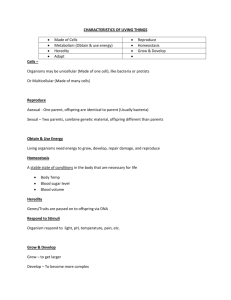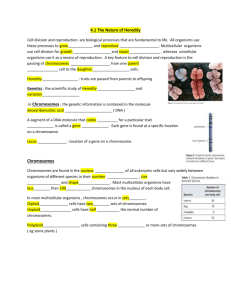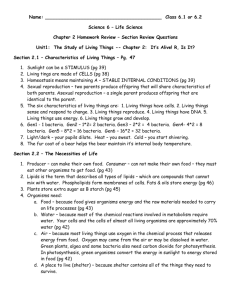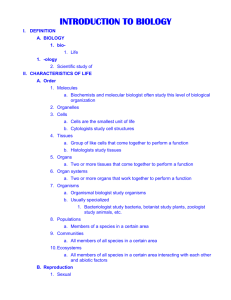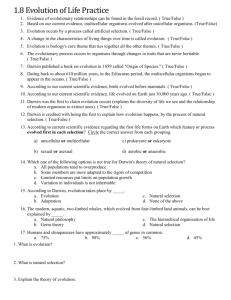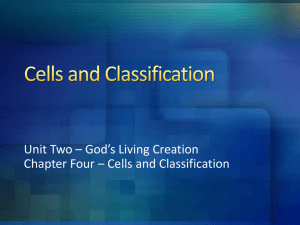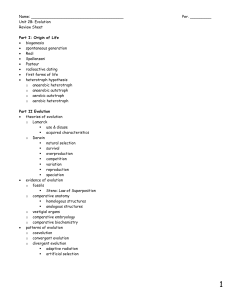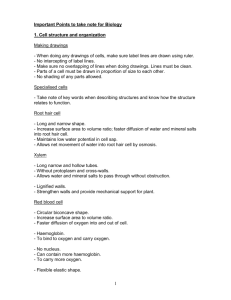Name Period ___ Date - Baldwin Schools Teachers
advertisement
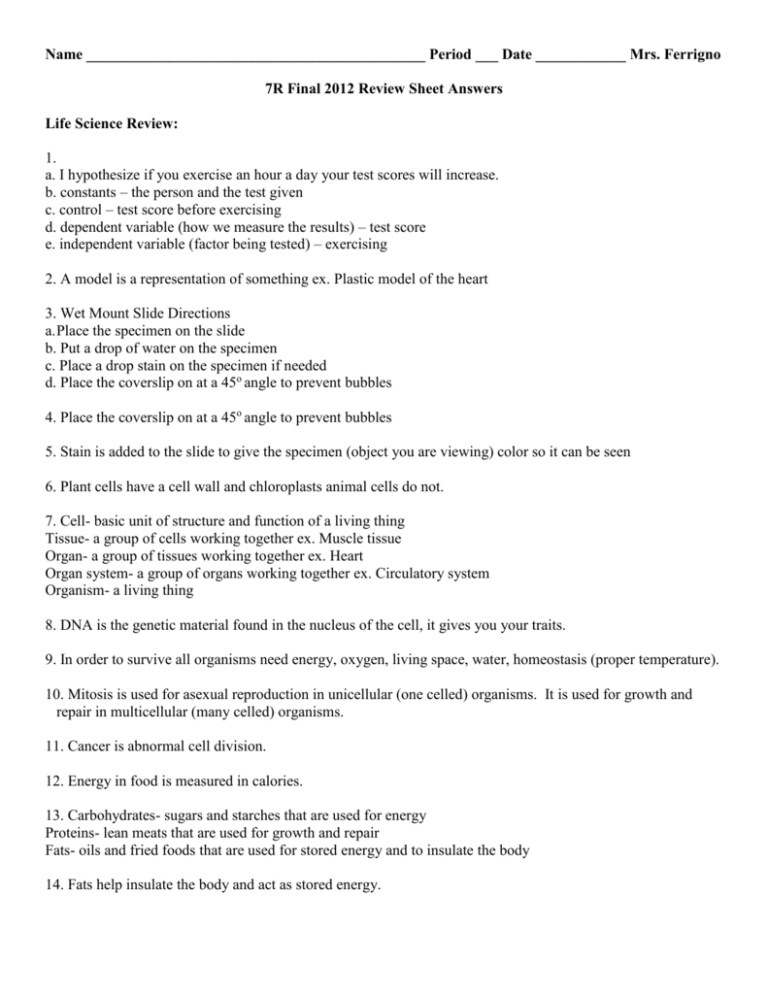
Name _____________________________________________ Period ___ Date ____________ Mrs. Ferrigno 7R Final 2012 Review Sheet Answers Life Science Review: 1. a. I hypothesize if you exercise an hour a day your test scores will increase. b. constants – the person and the test given c. control – test score before exercising d. dependent variable (how we measure the results) – test score e. independent variable (factor being tested) – exercising 2. A model is a representation of something ex. Plastic model of the heart 3. Wet Mount Slide Directions a. Place the specimen on the slide b. Put a drop of water on the specimen c. Place a drop stain on the specimen if needed d. Place the coverslip on at a 45o angle to prevent bubbles 4. Place the coverslip on at a 45o angle to prevent bubbles 5. Stain is added to the slide to give the specimen (object you are viewing) color so it can be seen 6. Plant cells have a cell wall and chloroplasts animal cells do not. 7. Cell- basic unit of structure and function of a living thing Tissue- a group of cells working together ex. Muscle tissue Organ- a group of tissues working together ex. Heart Organ system- a group of organs working together ex. Circulatory system Organism- a living thing 8. DNA is the genetic material found in the nucleus of the cell, it gives you your traits. 9. In order to survive all organisms need energy, oxygen, living space, water, homeostasis (proper temperature). 10. Mitosis is used for asexual reproduction in unicellular (one celled) organisms. It is used for growth and repair in multicellular (many celled) organisms. 11. Cancer is abnormal cell division. 12. Energy in food is measured in calories. 13. Carbohydrates- sugars and starches that are used for energy Proteins- lean meats that are used for growth and repair Fats- oils and fried foods that are used for stored energy and to insulate the body 14. Fats help insulate the body and act as stored energy. 15. The five kingdoms are: Moneran – unicellular without a nucleus ex. Bacteria and Blue-green Algae Protista – unicellular with a nucleus ex. Amoeba, Paramecium, Euglena Fungi – multicellular heterotroph (can’t make its own food) ex. Mushroom and Mold Plantae – multicellular, autotroph (can make its own food) ex. Flowers, Trees, Ferns Animalia – multicellular, heterotroph, specialized cells ex. Hydra, Insect, Human 16. Fungi obtain nutrients by breaking down dead plant and dead animal material. 17. Food provides heterotrophs with energy. 18. Green plants get energy from the Sun and photosynthesis- green plants use the sun’s energy, water, and carbon dioxide to produce food (glucose) and oxygen. This occurs in the chloroplasts of the cell. 19. Most of the atmospheric oxygen comes from plants undergoing photosynthesis. 20. The products produced from photosynthesis are glucose and oxygen. 21. Respiration- combines oxygen with food to produce energy and carbon dioxide 22. Bacteria which are microorganisms are living things that are too small to be seen without a microscope. Helpful- environmental cleanup, produce food, decomposes dead organisms. Harmful- cause infectious disease, food spoilage 23. Extinction is when a species dies out which happens because they are not reproducing. 24. Most diseases and infections are caused by microorganisms and/or bacteria. 25. Asexual reproduction- requires one parent, offspring are identical to the parent ex. Mitosis (cell splitting in two), worm cut each piece grows into a worm, budding (new organism grows out the side of parent), plant clippings grow new plants Sexual reproduction- requires two parents, offspring are not identical to the parents ex. joining of a sperm and an egg and seed production 26. Fertilization is the joining of a sperm and egg to produce a zygote. 27. Metamorphosis is when and organism undergoes a series of changes during development. Ex. Butterfly and Frog 28. Factors that affect your metabolism are age, gender, diet. Your intelligence doesn’t affect on your metabolism. 29. Stimulus- a change in the environment to cause a reaction ex. cold Response – a reaction to a stimulus ex. Shiver 30. Sexual reproduction has the advantage of creating offspring with a variety of traits. Asexual reproduction has the disadvantage of producing offspring with identical traits and no variety. 31. The function of the skeletal system is to provide shape, support, movement, store minerals, and produce red blood cells. 32. The function of the nervous system is to control body activities. Ex. Coordinate movement 33. The function of the muscular system is to allow movement by muscles contracting. 34. The function of the circulatory system is to deliver nutrients and oxygen to the cells and take wastes away from the cells. 35. The function of the digestive system is to breakdown food into useable nutrients. Mechanical digestion breaks food into smaller pieces ex. Teeth Chemical digestion breaks food into simpler substances ex. Enzymes changing starch to sugar 36. The function of the excretory system is to get rid of solid, liquid, and gaseous waste. 37. A hormone is a chemical that controls certain activities of the body. It is produced by the endocrine system. 38. The negative feedback mechanism controls the amount of hormones in your body to maintain equilibrium (homeostasis). 39. The function of the respiratory system is to take in oxygen and exchange it with carbon dioxide with the blood (circulatory system). Oxygen enters the alveoli in the lungs then passes into the capillaries into the blood. It travels to the heart then the rest of the body. At the body cells the blood picks up carbon dioxide, takes it to the heart then to the lungs where it passes into the alveoli to be exhaled out of the lungs. 40. Global warming is the Earth’s average temperature increasing due to the greenhouse effect from pollution. Due to burning fossil fuels. Prevent by using renewable resources, car pooling, mass transit (buses and trains). 41. Competition is when organism fight over limited resources (food, water, living space). This causes those that are best adapted to survive over those that aren’t (survival of the fittest). 42. Organisms in the same species are more similar than those in the same kingdom. 43. All living things are made up of cells. 44. Cell wall- protection and support (bricks) Cell membrane- controls what enters and leaves the cell (security) Vacuole- stores food, water and waste (closets) Cytoplasm- holds organelles and transports materials (rooms and hallways) Nucleus- controls all activities of the cell and contains genetic material (Principal) Chloroplast- captures the sun’s energy to perform photosynthesis (Cafeteria) 45. Normal Human Cell – 46 chromosomes Zygote (Fertilized Egg) – 46 chromosomes Human Sperm – 23 chromosomes Human Egg Cell – 23 chromosomes 46. Cross two hybrid tall pea plants: Tt x Tt T t TT Tt Tt tt Genotype: 25% Purebred Tall, 50% Hybrid Tall, and 25% Purebred Short Phenotype: 75% tall and 25% short 47. Genetic Engineering is when gene segments are placed into cells giving those cells a new trait. Example glowing gene from jellyfish put in bacteria makes bacteria glow. Selective breeding is when two specific organisms are breed for a desired offspring. Ex. breeding two white rats to produce white rats. 48. Producer (autotroph) – makes its own food with the Sun’s energy ex. Trees Consumer (heterotroph) – cannot produce its own food, must eat to get energy ex. Cow Decomposer – breaksdown dead plants and animals and returns nutrients to the soil ex. bacteria and fungi 49. Carnivore – eats only animals ex. tiger Herbivore – eats only plants ex. cow Omnivore – eats both plants and animals ex. human All of these are consumers. 50. Ecological succession is when an area changes over time as one species replaces another, for example grass area becomes a forest. 51. An adaptation is a mutation or trait that allows an organism to survive over others. Ex. camouflage or being able to survive in different environments 52. Pollutants make the air quality poor. 53. Variation in a species is caused by sexual reproduction and mutation. 54. Individuals make up populations which make up communities which are all part of an ecosystem. 55. The arrows in a food chain represent the flow of energy. 56. If food supplies decrease the population eating that food source will decrease. If food supplies increase the population eating that food source will increase. 57. Decomposers Consumers Producers 58. Three compounds cycled between the living and nonliving environment are water, oxygen, and carbon dioxide. Physical Science: 1. Renewable resources are those that can be replenished in our lifetime or won’t run out, for example solar energy, wind energy, wood, or running water. Nonrenewable resources cannot be replaced in our lifetime, for example fossil fuels (oil, coal, and gas). 2. Renewable resources benefit the environment because they do not pollute the air like burning fossil fuels do so they help prevent global warming. 3. We need to conserve nonrenewable resources because they are in a limited supply and can not be replaced in your lifetime. They can be conserved by using less (ex. car pooling, mass transit- bus or train) and by using renewable resources. 4. To determine the volume of an irregular shaped object use a graduated cylinder. Add the object to a measured amount of water and subtract the original volume from the new volume (water displacement method). 5. Shape Volume Solid Definite Definite Liquid Changes Definite Particle Speed Vibrate Flow Gas Changes Changes (Fills Container) Fast 6. Physical Change- change in appearance but still the same substance ex. phase change, tearing, crushing 7. Chemical Change- change into a new substance ex. burning, rust, bubbling chemical reactions 8. Freezing- liquid to a solid (Heat lost) Melting- solid to a liquid (Heat absorbed) Condensation- gas to a liquid (Heat lost) Evaporation- liquid to a gas (Heat absorbed) 9. Separating mixtures: Salt Water- evaporation Metal shavings and pepper- magnet Different sized rocks- screen filters 10. Solubility is the amount of solute that will dissolve in a solvent. In most cases, as the temperature increases the solubility increases. 11. You can increase the rate a substance will dissolve by crushing the solid, stirring, or heating it. 12. Acceleration Deceleration No Motion 13. A simple machine makes work easier by reducing the force needed. Inclined plane – ramp Screw – jar lid Wedge – knife Lever – crowbar, scissors Pulley – flag pole Wheel and axle – bicycle wheel 14. Add a lubricant (oil) to decrease friction in a machine. 15. Materials made of metal conduct electricity. Materials like plastic and rubber are insulators. 16. Like poles (two norths or two souths) repel and opposite poles (north and south) attract. 17. Dark clothes absorb light energy to keep you warmer in winter. Light clothes reflect light energy to keep you cooler in summer. 18. The periodic table lists all the elements and can be used to determine the properties of elements. 19. Chemical symbols are one or two letters that represent an element. Only the first letter is capitalized. Chemical formulas are letters used to represent compounds. They contain more than one capital letter. 20. Two ways you can increase the effect of gravity is by increasing the mass of the objects and decreasing the distance between the objects. 21. If two people pull with the same amount of force during a tug of war, neither person will move. If one person pulls with more force, they will move towards the greater force. 22. When riding a roller coaster, as you go down a hill the potential energy changes into kinetic energy. There will be the greatest kinetic energy at the bottom and the greatest potential energy at the top of the hill. 23. On a graph a phase change will appear as a flat line. 24. When using pulleys to move an object, you can decrease your force by adding more pulleys. 25. Refraction is the bending of light as it travels through a different medium. Example – A pencil appears to be broken when in a glass of water because light bends as it goes from the air to water this also causes a fish to appear to be in a different location when looking from above the water. 26. Sound is heard as particles vibrate. 27. You would see lightning before hearing the thunder during a storm, because light travels faster than sound. 28. If an object moves in one direction there is an opposing force acting on it in another. Example: As a ball rolls on the ground, it slows and stops due to friction opposing it.
